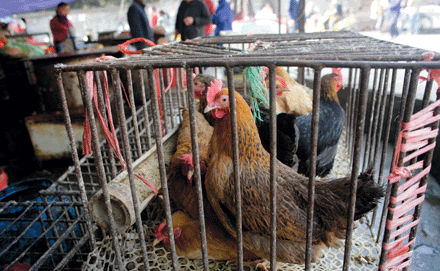Critics Skeptical as Flu Scientists Argue for Controversial H7N9 Studies

No gain?
Critics say gain-of-function studies with the H7N9 bird flu virus wouldn’t help guide defense measures, such as culling chickens at markets in China.
CREDIT: SUN CHEN/IMAGINECHINA/AP IMAGES
Flu scientists are hoping to vaccinate themselves against another outbreak of a crippling controversy.
In a letter published this week by Nature and Science (see p. 612), 22 researchers make their case for launching potentially risky experiments with the H7N9 avian influenza virus, which emerged earlier this year in China and which some scientists fear could spark a deadly human pandemic. The scientists, who mostly work in U.S.-funded labs, also detail the safety and security precautions that they would take to prevent the possibly dangerous viruses they create from escaping from the lab—or falling into the hands of terrorists. In an accompanying online letter (http://scim.ag/fluHHS), officials from the U.S. Department of Health and Human Services (HHS) write that they will require extra review of especially problematic studies.
The communiqué, the authors say, is intended to head off the kind of global controversy that in 2011 engulfed researchers conducting experiments with another avian flu virus, H5N1, halting certain studies for more than a year (Science, 22 June 2012, p. 1494). Critics charged that those studies—which involved engineering new H5N1 strains able to move between mammals, and not just birds—carried risks that outweighed any benefits and had too little public oversight.
“With H5N1, we were criticized for not being transparent,” says virologist Ron Fouchier of Erasmus MC in Rotterdam, the Netherlands, one of the scientists at the center of the H5N1 storm and a lead author of the 7 August letter. “So this time we want to be sure the public understands what we want to do before we do it, why we need to do it, and how we are going to do it safely.”
The openness offensive isn’t quieting critics. “The scientific justification presented for doing this work is very flimsy, to put it mildly, and the claims that it will lead to anything useful are lightweight,” says Adel A. F. Mahmoud, an infectious disease specialist at Princeton University and the former president of Merck Vaccines. And the security precautions are “insufficient and amazingly lame,” says molecular biologist Richard Ebright of Rutgers University in Piscataway, New Jersey.
At issue are gain-of-function studies, in which researchers use several techniques to give viruses characteristics that they don’t have in nature, such as the ability to infect new species or transmit more easily through the air. Such studies are critical to understanding the sometimes subtle changes that can make a bird virus a pandemic threat, some scientists argue, and to developing better vaccines and surveillance. But others are skeptical and say that just because scientists can do the experiments doesn’t mean they should.
The dispute went public in late 2011, after Fouchier and virologist Yoshihiro Kawaoka of the University of Wisconsin, Madison, submitted papers on their mammal-transmissible H5N1 viruses to Science and Nature, respectively. A U.S. government panel, the National Science Advisory Board for Biosecurity (NSABB), recommended against publishing complete versions, for fear the details might provide a bioweapon blueprint. Ultimately, a divided NSABB supported full publication, but only after H5N1 researchers had declared a voluntary moratorium on gain-of-function studies and the U.S. government imposed new regulations.
The world can’t afford to repeat that uproar, the letter’s authors suggest. “[E]xperiments that may result in GOF [gain-of-function] are critical” to gauging H7N9 risks and preparing defenses, they write, and there is little time to lose. Although no new human H7N9 cases have appeared recently, the virus has killed 43 of the 134 people it is known to have infected; some researchers fear that it will reemerge this fall. There is no reliable vaccine. And this week, researchers reported in BMJ the first probable case of person-to-person transmission, between a father and his adult daughter; both died.
To attack these problems, researchers need to get moving on five lines of research, the authors write, including transmissibility and drug resistance studies. To reduce risks, they pledge to work only in “enhanced” biosafety level 3 (BSL 3+) labs and not to create superbugs by adding capabilities to viruses already able to resist drugs or evade immune defenses. To bolster their case, they suggest that the controversial H5N1 research has already paid off, because it helped identify worrisome mutations that “factored into” Chinese and global risk assessments of H7N9.
That last claim incenses some critics. Knowledge of those mutations was not necessary to recognize H7N9’s risk, Mahmoud argues. Nor was it “essential to containing the virus in China by closing poultry markets,” says virologist Simon Wain-Hobson of the Institut Pasteur in Paris. “The mutations guided nothing.” Moreover, gain-of-function studies are unlikely to predict whether H7N9—or any other virus—will actually become a pandemic virus, critics argue. “It’s laughable to claim that,” Mahmoud says. And Ebright argues that all such studies should be confined to more secure BSL-4 labs.
The debate will get specific as researchers submit proposals to the U.S. government, the most likely funder. (Other nations have shown less interest.) HHS says that a special panel will review proposals involving transmissibility. The process could be long; Fouchier says that U.S. officials are still reviewing requests he and Kawaoka made early this year to resume gain-of-function studies with H5N1. In the meantime, some prominent H7N9 researchers, including Chen Hualan, director of China’s National Avian Influenza Reference Laboratory in Harbin, say they have no plans to pursue such studies.







